

Microbe Organics. Slideshare. Anic Waste Matters Permaculture Research Institute. By Kym Kruse, of Free Range Permaculture Next time you go to throw that banana peel in the bin, stop and think about the environmental impact that action has.
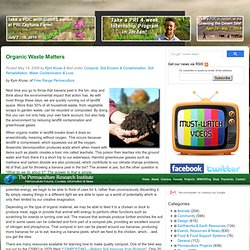
As with most things these days, we are quickly running out of landfill space. More than 50% of all household waste, from vegetable scraps to garden waste, can be recycled or composted. By doing this you can not only help your own bank account, but also help the environment by reducing landfill contamination and greenhouse gases. When organic matter in landfill breaks down it does so anaerobically, meaning without oxygen. The first step required is a paradigm shift toward so called “waste”. Depending on the type of organic material, we may be able to feed it to a chicken or duck to produce meat, eggs or provide that animal with energy to perform other functions such as scratching for insects or turning over soil. There are many resources available for learning how to make quality compost.
ILDIS home page. Compost miracles Permaculture Research Institute. Excerpted from the Humanure Handbook by Joe Jenkins.

Compost microorganisms not only convert organic material into humus, but they also degrade toxic chemicals into simpler, benign, organic molecules. Fast compost - Soil Permaculture Design and Maintenance Permaculture Research Institute. What is Compost?

Compost is humanity’s version of the humus found in nature, and the compost heap is a ‘digester’ – our tool used to produce it. Humus is made of broken down vegetation which releases nutrients back into the soil for healthy plant growth. Similarly, under the direction of the careful gardener, the composting process breaks down a rich mixture of ingredients to produce a potent humus which will regenerate soil and foster vigorous plant growth. Virtually anything which has once lived can be composted – although selecting the most appropriate mixture of ingredients from what is available can be seen at first as something of a ‘dark art’. Time spent in quiet observation of the natural processes of your garden will never be wasted. Why make Compost? Strong and healthy plants have their own natural resistance to pests and diseases and compost is the natural, home grown, method of achieving this.
How to make Compost Material C/N ratio Method (for a ‘hot’ heap) 18-Day Compost – the Appliance of Science Permaculture Research Institute. You may have got beyond the ‘heave it in and hope’ stage of composting, but the average heap or bin still involves a lot of trial and error.
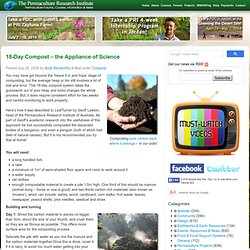
This 18-day compost system takes the guesswork out of your heap and turbo-charges the whole process. But, it does require consistent effort for two weeks and careful monitoring to work properly. Here’s how it was described to LeafTurner by Geoff Lawton, head of the Permaculture Research Institute of Australia. As part of Geoff’s academic research into the usefulness of this approach he has successfully composted the discarded bodies of a kangaroo, and even a penguin (both of which had died of natural causes). But it is not recommended you try that at home! Posting-making-soil-improver-from-rubbish. Weeds, Guardians of the Soil. Wonder Weeds Permaculture Research Institute.
PIJ #63, June-Aug 1997 by Linda Woodrow How to harvest weeds for their best nutrients Sometimes gardening seems to me like alchemy.
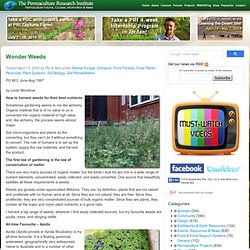
Wonder Weeds Permaculture Research Institute. Weeds as Soil Indicators. Weed Photo Gallery. Dirt! The Movie. Biochar References Articles Books. Five Fertility Principles. Phosphorus Matters II - Keeping Phosphorus on Farms Permaculture Research Institute. Editor’s Prelude: Peak Phosphorus barely registers alongside it’s more gregarious, attention-getting bigger brother, Peak Oil.
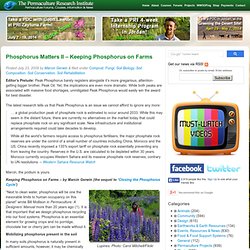
Yet, the implications are even more dramatic. While both peaks are associated with massive food shortages, unmitigated Peak Phosphorus would easily win the award for best disaster. The latest research tells us that Peak Phosphorus is an issue we cannot afford to ignore any more: … a global production peak of phosphate rock is estimated to occur around 2033. While this may seem in the distant future, there are currently no alternatives on the market today that could replace phosphate rock on any significant scale. Phosphorus Matters Permaculture Research Institute. Part One: Closing the Phosphorus Cycle It might sound ridiculous, but for every container of bananas, coffee, tea or cocoa imported, we should send back a shipment of a fluffy, earth-like smelling compost.
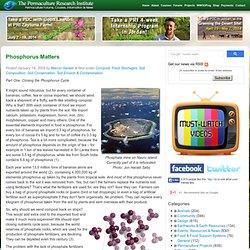
Why is that? With each container of food we import nutrients taken up by plants from the soil. Weeds as Indicators Of Soil Conditions Stuart B. Hill & Jennifer Ramsay - Ridgetown Horticultural Society. Confronted with a weedy field or garden, one's instinctive reaction is to rush out and destroy the weeds before they take over.
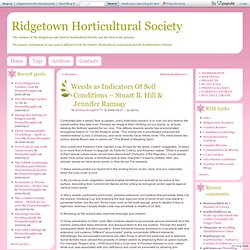
Perhaps we imagine them choking out our plants, or, at least, stealing the fertilizer applied for our crop. This attitude towards weeds has predominated throughout history. In 110 AD Plutarch wrote, "The richest soil if uncultivated produces the rankest weeds" (Lives: Coriolanus); and more recently Oscar Wilde wrote "The vilest deeds like poison weeds Bloom well in poison air" (The Ballad of Reading Gaol). Only Lowell and Emerson have injected a ray of hope for the weed. Lowell I suggested, "A weed is no more than a flower in disguise" (A Fable for Critics); and Emerson asked, "What is a weed? Lectures:GA. Soil Biology Movies. Creating a future that works.
Welcome. Soil and Health Library. Soil - Our Financial Institution Permaculture Research Institute. Soil — the substance you walk on, build on, and live from — provides your food, clothing, and even the air you breathe.
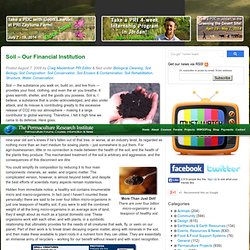
It gives warmth, shelter, and the goods you possess. Soil is, I believe, a substance that is under-acknowledged, and also under attack, and its misuse is contributing greatly to the excessive release of CO2 into our atmosphere – making it a large contributor to global warming. Therefore, I felt it high time we came to its defense. Here goes. Firstly, what is soil? You could simplify its composition by reducing it to four main components: minerals, air, water, and organic matter. Hidden from immediate notice, a healthy soil contains innumerable micro and macro-organisms. This natural process of micro-organisms feeding plants is significant, and highly complex. Yeomans Plows - Keyline Systems & Concepts Priorty One. Reference to the contour diagram of a primary valley (see Fig. 4) will show that the Keyline of the valley (which is marked in as an almost true contour) the contours are closer together in the centre of the valley than they are out to the sides; but below the Keyline, the contours are farther apart in the bottom of the valley than they are a little distance out, where the primary valley shape gradually changes to the primary ridge shape.
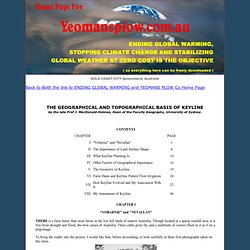
In order to cultivate this valley so that the first flow of water will spread wider and move outwards from the valley bottom, it is only necessary to cultivate parallel to the Keyline up the slope. Welcome! Our Good Earth — Photo Gallery. Slideshare.